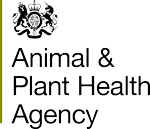
The Animal and Plant Health Agency (APHA) was launched on 1 October 2014, merging the former Animal Health and V eterinary Laboratories Agency (AHVLA) with parts of the Food and Environment Research Agency (FERA) responsible for plant and bee health to create a single agency responsible for animal, plant and bee health. The agency works to safeguard animal and plant health for the benefit of people, the environment and the economy. Their headquarters are located in Weybridge, Surrey. The agency employs around 2,300 staff, based at various sites across the UK.
eterinary Laboratories Agency (AHVLA) with parts of the Food and Environment Research Agency (FERA) responsible for plant and bee health to create a single agency responsible for animal, plant and bee health. The agency works to safeguard animal and plant health for the benefit of people, the environment and the economy. Their headquarters are located in Weybridge, Surrey. The agency employs around 2,300 staff, based at various sites across the UK.
APHA is responsible for:
- identifying and controlling endemic and exotic diseases and pests in animals, plants and bees, and surveillance of new and emerging pests and diseases
- scientific research in areas such as bacterial, viral, prion and parasitic diseases and vaccines, and food safety
- ensuring high standards of welfare in farmed animals
- facilitating trade in animals and in products of animal origin
- protecting endangered wildlife through licensing and registration
- managing a programme of apiary (bee) inspections, diagnostics, research and development, and training and advice
- regulating the safe disposal of animal by-products to reduce the risk of potentially dangerous substances entering the food chain
The majority of the expertise contributing to the RISKSUR project will be provided by members of the Department of Epidemiological Sciences. The department has around 30 scientists working on a range of surveillance and research projects covering many nationally and internationally important animal health issues. Our aim is to produce high quality, relevant science and to provide evidence to our policy customers. We collaborate with a multitude of organizations including universities, other government agencies, the private sector, EU and other international partners.
Role in the project
Participant in WP 1, 2, 3, 4, 5,6, 7 | Co-leadership of WP 1 and 2 | Conceptual surveillance framework development | Development of frameworks and tools for disease detection, | Facilitate communication with UK policy makers and other stakeholders | Provision of UK data for case studies | Carry out case-studies on real data from the UK surveillance programme in WP 2 and 5 | Contribution to scientific dissemination and development of best practice guidelines in WP 7.
Key-persons assigned to RISKSUR
 Lucy Snow
Lucy Snow
Lucy is an epidemiologist in the Department of Epidemiological Science. She graduated in Zoology from the University of Edinburgh before completing an MSc in Veterinary Epidemiology followed by a PhD in vector borne disease. She joined the APHA as an epidemiologist in 2004 working on emerging disease in pigs. More recently she has been involved in the surveillance and control of zoonotic disease, leading and managing projects on Salmonella, E.coli (including antimicrobial resistance) and avian influenza. She currently leads the APHA tasks within RISKSUR.
Adam Brouwer
Adam graduated with a degree in Biological Sciences from the University of Reading. His key areas of expertise lie in Bovine Tuberculosis and Avian Influenza surveillance and research. His current role involves quantitative analysis, modeling and GIS. He is also an epidemiologist for EU Reference Laboratory for Avian Influenza.
 Andrew Breed
Andrew Breed
Andrew is a veterinary epidemiologist at the APHA. His current role involves: leading and managing projects in national and international veterinary public health; duty epidemiologist on call for notifiable disease outbreaks; lead epidemiologist for EU/OIE/FAO Reference Laboratory for Avian Influenza; epidemiology associate for Virology Department; supervision of postgraduate students; and member of APHA’s Wildlife Expert Group and Academic Board. He is a Diplomate of the European College of Zoological Medicine and recognised veterinary specialist in Wildlife Population Health. He has published widely on the epidemiology and ecology of bat-borne zoonotic viruses and avian influenza, as well as other viral pathogens. He completed a PhD on the epidemiology of Hendra and Nipah viruses at the Australian Biosecurity Cooperative Research Centre for Emerging Infectious Disease. He is a member of the IUCN’s Wildlife Health Specialist Group and has been a principal investigator or participant in a range of European projects including FLUTEST, FLURISK, CALLISTO, EPIZONE, COMPARE and ANTIGONE.
Selected References
- Horton DL, McElhinney LM, Freuling CM, Marston DA, Banyard A, Goharriz H, Wise E, Breed AC, Saturday G, Kolodziejek J, Zilahi E, Al-Kobaisi MF Nowotny N, Mueller T and Fooks AR (2015) Complex epidemiology of a zoonotic pathogen in a culturally diverse region: Phylogeography of rabies virus in the Middle East. PLoS Neglected Tropical Diseases. In Press.
- Marier EA, Snow LC, Floyd T, McLaren IM, Bianchini J, Cook AJ, Davies RH (2014) Abattoir based survey of Salmonella in finishing pigs in the United Kingdom 2006-2007. Prev Vet Med. 117(3-4):542-53.
- Von Dobschuetz S, De Nardi M, Harris K, Munoz O, Breed AC, Wieland B, Dauphin G, Lubroth J and Stark K. (2014) Influenza surveillance in animals: What is our capacity to detect emerging influenza viruses with zoonotic potential? Epidemiology and Infection. Epub ahead of print.
- Hill A, Brouwer A, Donaldson N, Lambton S, Buncic S, Griffiths I. (2013). A risk and benefit assessment for visual-only meat inspection of indoor and outdoor pigs in the United Kingdom Food Control. 03/2013; 30(1):255–264.
- Arnold MA, Irvine RM, Rae D, Cook AJC, Brown IH and Breed AC. (2012) Investigation into sampling strategies in response to a potential outbreak of Low Pathogenicity Notifiable Avian Influenza in commercial duck holdings in Great Britain. Epidemiology and Infection. 141, 751-762.
- Breed AC, Irvine RM, Duncan D, Rae D, Snow L, Cook AJ, Brown IH, (2012) An evaluation of wild bird avian influenza surveillance in Great Britain. Avian Dis. 56(4 Suppl):986-91.
- Brugman VA, Horton DL, Phipps LP, Johnson N, Cook AJC, Fooks AR and Breed AC. (2012) Epidemiological perspectives on West Nile Virus surveillance in Great Britain. Epidemiology and Infection. 141 (6) 1134 - 1142.
- Ely ER, Nicholson RE, Snow LC, Strugnell BW, Williamson SM, Milnes AS, Watson EN, Hoinville LJ. (2012) Evaluation of methods for measuring coverage and representativeness of an early-warning disease surveillance system.Vet Rec. 171(17):423.
- Gale P, Stephenson B, Brouwer A, et al. (2012). Impact of climate change on risk of incursion of Crimean-Congo haemorrhagic fever virus in livestock in Europe through migratory birds. Journal of Applied Microbiology: 112(2);246-257
- Kelly L, Brouwer A, Wilson A, Gale P, Snary E, de Vos CJ. (2012). Epidemic Threats to the European Union: Expert Views on Six Virus Groups. Transboundary and Emerging Diseases 07/2012
- Snow LC, Wearing H, Stephenson B, Teale CJ, Coldham NG. (2011) Investigation of the presence of ESBL-producing Escherichia coli in the North Wales and West Midlands areas of the UK in 2007 to 2008 using scanning surveillance. Vet Rec. 169(25):656.
- Snow LC, Davies RH, Christiansen KH, Carrique-Mas JJ, Cook AJ, Evans SJ. (2011) Survey of Salmonella prevalence on commercial turkey breeding and fattening farms in the UK in 2006 to 2007. Vet Rec. 169(19):493.
- Breed AC, Harris K, Hesterberg U, Piazza V, Pittman M, Cook AJC and Brown IH. (2010) Surveillance for avian influenza in wild birds in the European Union in 2007. Avian Diseases. Vol 54, 399-404.
- Breed AC, Yu M, Barr JA, Crameri G, Thalmann CM and Wang LF. (2010) High prevalence of antibodies to henipaviruses and rubulaviruses in pteropid bats, Papua New Guinea. Emerging Infectious Diseases. Vol 16, 1997-1999.
- Gale P, Brouwer A, Ramnial V, Kelly L, Kosmider R, Fooks AR, Snary EL. (2010). Assessing the impact of climate change on vector-borne viruses in the EU through the elicitation of expert opinion. Epidemiology and Infection: 138(2);214-225
- Rosmider RD, Kelly L, Simons RL, Brouwer A, David G. (2010). Detecting new and emerging diseases on livestock farms using an early detection system. Epidemiology and Infection 11/2010; 139(10):1476-85.
- Hoinville L, Ellis-Iversen J, Vink D, Watson E, Snow L and Gibbens J. (2009) Discussing the development and application of methods for effective surveillance in livestock populations: Report of a workshop held prior to the ISVEE conference, Durban, South Africa available at http://www.defra.gov.uk/ahvla-en/disease-control/surveillance/pre-isvee-...
- Snow LC, Newson SE, Musgrove AJ, Cranswick PA, Crick HQ, Wilesmith JW. (2007) Risk-based surveillance for H5N1 avian influenza virus in wild birds in Great Britain. Vet Rec. 2007 Dec 8;161 (23):775-81.
- Truscott J, Garske T, Chis-Ster I, Guitian J, Pfeiffer D, Snow L, Wilesmith J, Ferguson NM, Ghani AC (2007) Control of a highly pathogenic H5N1 avian influenza outbreak in the GB poultry flock. Proc Biol Sci. 274(1623):2287-95.
